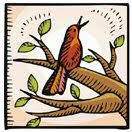Why native trees are a great choice
1. Native trees are naturally adapted to the climate of their area.
 2. The native trees of an area are part of its history and heritage and should be preserved and honored for that reason.
2. The native trees of an area are part of its history and heritage and should be preserved and honored for that reason.3. Native trees provide food and shelter needed by native wildlife.
4. Native trees often have a greater measure of natural tolerance to local insect pests, diseases, and weather conditions thus requiring less maintenance to maintain their health.
5. Native trees have a natural beauty suited to their natural habitat.
6. Native trees help to preserve the authenticity of the landscape.
7. Native trees promote a healthy ecosystem and balance of nature.
8. Native trees are often available free of charge--yours for the planting or transplanting.
 9. The planter of a long-lived native tree leaves a lasting legacy and a valuable gift to those who will follow him on this earth.
9. The planter of a long-lived native tree leaves a lasting legacy and a valuable gift to those who will follow him on this earth.10. Planting native trees helps to preserve both local and global biodiversity.

 "The power to recognize trees at a glance without examining their leaves or flowers or fruit as they are seen, for example, from the car-window during a railroad journey, can only be acquired by studying them as they grow under all possible conditions over wide areas of territory. Such an attainment may not have much practical value, but once acquired it gives to the possessor a good deal of pleasure which is denied to less fortunate travelers."
"The power to recognize trees at a glance without examining their leaves or flowers or fruit as they are seen, for example, from the car-window during a railroad journey, can only be acquired by studying them as they grow under all possible conditions over wide areas of territory. Such an attainment may not have much practical value, but once acquired it gives to the possessor a good deal of pleasure which is denied to less fortunate travelers."
0 comments -- please add yours:
Post a Comment